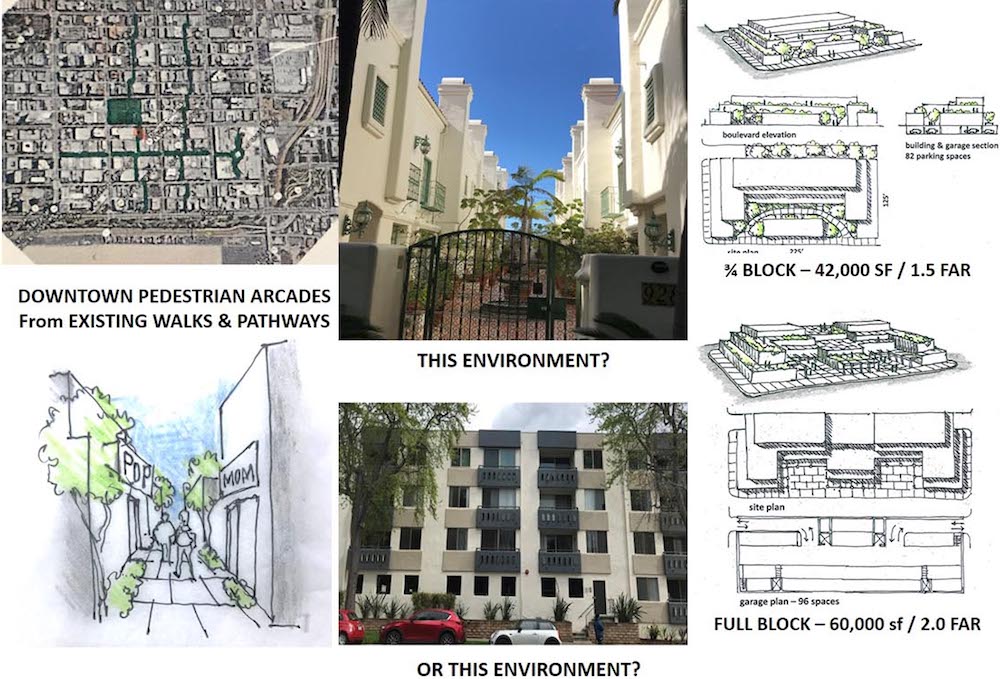
This is the third of a four-part article dealing with the very serious problem in which the development community in bed with Sacramento has challenged the residents of Santa Monica.
The first article outlined the failure of past City Councils, in collaboration with developers, produced only 8% of a 30% goal of “inclusionary” housing in exchange for increased height and density. And reducing rents for the 8% inclusionary housing has only increased rents for the 92% of market rate units. The city has become a cash cow for developers! To correct this glaring problem, I’m suggesting the use of a modest amount of the 177 parcels owned by the city, much of which is either inefficiently used, or not in use. This property would be developed by the city for affordable “garden apartments.” Without the benefit of zero land cost, lower construction cost, and with reduced financing, permit processing costs, and city property taxes, there would be a 30-35% overall savings. And this would also result in reduced rents for the remaining 92% market rate units. Additionally, it could pave a way for renters of the affordable units built on city property to apply their rental payments toward ownership once the city’s construction loan is paid off from their monthly rentals.
The second article dealt with the unfortunate partnership between developers and Sacramento under the guise of a substantial housing shortage calling for Santa Monica to provide 8,900 units of housing, including 6,000 affordable, in the next 8 years. But currently with over 4,000 vacant units in Santa Monica, and with 1,100 in construction, we instead have an affordability crisis? The SCAG numbers are a runaway trainwreck. This baseless number translates into an all-out effort to “upzone” our city. This ecologic and economic disaster of providing for a 20% increase in population also requires a corresponding 20% increase in infrastructure – water, power, sewage, police & fire, schools & libraries, etc. Not only is this 8,900 number baseless, but our zoning capacity as currently exists can provide this growth should it ever be necessary! Increasing housing supply through de-regulation is nonsense – benefitting only developers and land speculators. “Upzoning” is the antithesis of a progressive housing policy.
Which brings us to this third article which I believe leads to a path forward – a path of reconciliation to maintain Santa Monica’s DNA. “Upzoning” and “inclusionary” housing is not the answer for our vibrant and creative community. It’s time to look beyond the lunacy of SCAG and discuss real solutions, what our city could look like while still allowing profitable but also creative development. Vacant or underutilized downtown, boulevard, and multi-family zoned properties along with repurposing vacant retail and office space, providing ADUs (Accessory Dwelling Units) on single-family properties and even conversion of Airbnb units are all adequate answers to provide the density, height, design and open space necessary and appropriate to Santa Monica while staying within our basic height limits of 32 feet and 3 stories. And this can provide profits appropriate to the developers without adding one more foot in height, much less one story! In other words, existing zoning has substantial capacity, without “canyonizing” our community!
Downtown: The downtown area is over 4.2% of our city. 15% of this area is either vacant or paved parking or has a one-story building on a portion of the site. This represents over 1 million square feet of property and 2.75 million square feet of development at a 2.75 FAR (floor area ratio). This would provide over 2,200 – 2nd, 3rd & 4th floor apartments above 650,000 sf of new ground floor commercial or live/work space. After recouping the lost income from 2 years of construction and leasing, the property’s owner/developer will then realize a 300% increase in net income.
Boulevards: The boulevards are 7.6% of our city. There are currently 20-25 block-long sites and 30-35 half-block sites which are vacant with surface parking or a combination of parking and smaller one-story buildings. Re-developing these properties, with 2-stories of residential overlooking ground floor commercial or live/work space around courtyards or meandering sidewalks behind “Mom & Pop” shops, will offer relief from the continuous building blocks hugging narrow sidewalks. These properties re-developed can provide over 2,000 apartments and 800,000 sq ft of ground floor commercial or live/work space. And lost income during the 2 years of construction and leasing can become a 300% or more increase in rentable income in the 3rd or 4th year. Instead of “upzoning,” let’s use this mandate as a vehicle to re-direct the character of our boulevards!
R2 Multi-family: There are more than 30-35 parcels within a block of these boulevards which are vacant or with surface parking and could house over 500 garden apartments!
Vacant Commercial: There’s literally a ton of vacant retail and office space, more than one million sq ft – 15-20% in Santa Monica with vacancies even higher on the Promenade and along the mall in Santa Monica Place where both Bloomingdales and Banana Republic permanently closed! Wouldn’t mixed-use along these 2 malls look awfully attractive in addition to invigorating tourism and bringing back “mom & pop” space which couldn’t afford the recent higher corporate rents! Upper floor office space can re-locate to the ground floor. And re-purposing vacant retail and office space is easier to remodel and quite economical with existing parking, the building’s shell already in place, and permit processing much easier. And there’s all the hotels in question! And of course all this potential is limited by the capacity of our infrastructure!!! By code, every new building must be net zero, which means 3 stories in height! All this in addition to the 4,000 currently vacant units along with 1,100 currently under construction! Goodbye “upzoning” !!
ADU’s & Jr. ADU’s: And when you add 9,000 single-family homes to the list along with Airbnb units standing vacant from the lack of tourism, the capacity far exceeds any reasoned limit of growth.
So how can we turn a negative into a positive? How can we take advantage of all this capacity while dealing with unrealistic state mandates? Can we make this housing element positive instead of “canyonizing” our city? And what will our city look like after 8 years of this housing mandate? Will we continue to be a low-rise city? Can we discuss the quality of growth as well as the quantity of growth? If we need to plan for all this housing, can we also plan for the environment the residents will dwell in?
With our city divided and our city administration in flux, with an interim city manager and city attorney, we are a house divided, a city divided!
Next week’s article will address these issues – please stay tuned.
Ron Goldman FAIA for SMa.r.t.
(Santa Monica Architects for a Responsible Tomorrow)
Thane Roberts, Architect, Robert H. Taylor AIA, Ron Goldman FAIA, Architect, Dan Jansenson, Architect, Building and Fire-Life Safety Commission, Samuel Tolkin Architect, Mario Fonda-Bonardi, AIA, Planning Commissioner, Marc Verville CPA Inactive, Michael Jolly, AIRCRE
For previous articles see www.santamonicaarch.wordpress.com/writing













